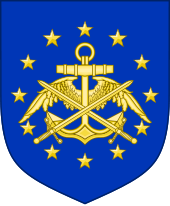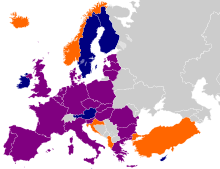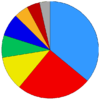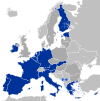- Military of the European Union
-
Military of the European Union 
The coat of arms of the EU military staffService branches EUMS Leadership Commander-in-Chief 27 EU heads of state High Representative Catherine Ashton Director General of EUMS Lt.Gen. Ton van Osch [1] Manpower Military age 17-45 Active personnel 1,695,122 Reserve personnel 2,614,491
755,034 paramilitaryExpenditures Budget $299.7 billion Percent of GDP 1.63% The military of the European Union today comprises the several national armed forces of the Union's 27 member states, as the policy area of defence has remained primarily the domain of nation states. European integration has however been deepened in this field in recent years, with the framing of a Common Security and Defence Policy (CSDP) branch for the Union's Common Foreign and Security Policy (CFSP) as well as the creation of separate international forces revolving around the EU's defence. A number of CSDP military operations have been deployed in recent years.
Several prominent leaders, including French President Nicolas Sarkozy, German Chancellor Angela Merkel, Italian Foreign Minister Franco Frattini and former Belgian Prime Minister Guy Verhofstadt, have voiced support for a common defence for the Union.[2][3][4] This possibility, requiring unanimous support among the member states, was formally laid down in Article 42 of the Treaty on European Union upon the entry into force of the Treaty of Lisbon on 1 December 2009.[5]
Additionally, the Treaty of Lisbon extended the enhanced co-operation provision to become available for application in the area of defence. This mechanism enables a minimum number of member states to deepen integration within the EUs institutional framework, without the necessity of participation for reluctant member states. The Polish government has announced its intention of examining the possibility of applying this provision in the area of defence during its Presidency of the Council of the European Union in the second half of 2011.[6] This move has as of December 2010 been publicly supported by several national governments.[7]
Contents
History
Following the end of World War II and the defeat of Nazi Germany, the Dunkirk Treaty was signed by France and the United Kingdom on 4 March 1947 as a Treaty of Alliance and Mutual Assistance against a possible German attack in the aftermath of World War II. The Dunkirk Treaty entered into force on 8 September 1947. The 1948 Treaty of Brussels established the military Western Union Defence Organization with an allied European command structure under Field Marshal Montgomery. Western European powers, except for Ireland, Sweden, Finland and Austria, signed the North Atlantic Treaty alongside the United States and Canada which only created a passive defence association until 1951 when, during the Korean War, the existing and fully functioning Western Union Defence Organization was augmented to form the North Atlantic Treaty Organization, NATO.
In the early 1950s, France, Germany, Italy and the Benelux countries made an attempt to integrate the militaries of mainland Western Europe, through the treaty establishing the European Defence Community (EDC). This scheme did however not enter into force, as it failed to obtain approval for ratification in the French National Assembly, where Gaullists feared for national sovereignty and Communists opposed a European military consolidation that could rival the Soviet Union.
The failure to establish the EDC resulted in the 1954 amendment of the Treaty of Brussels at the London and Paris Conferences which in replacement of EDC established the political Western European Union (WEU) out of the earlier established military Western Union Defence Organization and included West Germany and Italy in both WEU and NATO as the conference ended the occupation of West Germany and the defence aims had shifted from Germany to the Soviet Union.
Out of the 27 EU member states, 21 are also members of NATO. Another 3 NATO members are EU Applicants and 1 is solely a member of the European Economic Area. In 1996, the Western European Union (WEU) was tasked by NATO to implement a European Security and Defence Identity within NATO, which later was passed over to the EU Common Security and Defence Policy as all Western European Union functions were transferred to the European Union through the Lisbon Treaty. The memberships of the EU and NATO are distinct, and some EU member states are traditionally neutral on defence issues. Several of the new EU member states were formerly members of the Warsaw Pact.
The EU currently has a limited mandate over defence issues, with a role to explore the issue of European defence agreed to in the Amsterdam Treaty, as well as oversight of the Helsinki Headline Goal Force Catalogue (the 'European Rapid Reaction Force') processes. However, some EU states may and do make multilateral agreements about defence issues outside of the EU structures.
On 20 February 2009 the European Parliament voted in favour of the creation of Synchronized Armed Forces Europe (SAFE) as a first step towards a true European military force. SAFE will be directed by an EU directorate, with its own training standards and operational doctrine. There are also plans to create an EU "Council of Defence Ministers" and "a European statute for soldiers within the framework of Safe governing training standards, operational doctrine and freedom of operational action".[8]
Implications of the Treaty of Lisbon
The entry into force of the Treaty of Lisbon triggered member states of the Western European Union (WEU) to scrap the organisation, which had largely become dormant, but they have kept the mutual defence clause of the Treaty of Brussels as a basis for a possible EU mutual defence arrangement.
The Treaty of Lisbon also states that:
“ The common security and defence policy shall include the progressive framing of a common defence policy. This will lead to a common defence, when the European Council, acting unanimously, so decides. (TEU, Article 42) [9] ” Militaries of Member States
France and the United Kingdom
France and the United Kingdom represent the EU's two most dominant global military powers and are also Europe's only two nuclear powers. Together, France and the United Kingdom account for 45 per cent of Europe's defence budget, 50 per cent of its military capacity and 70 per cent of all spending in military research and development.[10] The 2010 Anglo French defence treaty will "pool resources" of these two nations' armed forces to maintain their status as major "global defence powers". France and the United Kingdom will also work jointly with nuclear weapons, "testing will be carried out in France and the technology will be developed in the UK." [11]
Defence Spending
The combined defence budgets of the 27 EU member states in 2010 amounted to $299.7 billion.[12] This represents 1.63% of European Union GDP, second only to the US military's $698.1 billion 2010 defence budget, which represents 4.5% of United States GDP. The EU figures include the spending for joint projects such as the Eurofighter and joint procurement of equipment.

The hypothetically combined EU military
budget compared to other military powers in 2010
Figures sourced from SIPRI and EDA.Country Defence Budget[13] ($ Dollars) % of GDP Date (2010) 
European Union $299,768,000,000 1.63% 2010 
France $61,285,000,000 2.32% 2010 
United Kingdom $57,424,000,000 2.32% 2010 
Germany $46,848,000,000 1.27% 2010 
Italy $38,303,000,000 1.44% 2010 
Spain $25,507,000,000 1.16% 2010 
Netherlands $11,604,000,000 1.43% 2010 
Poland $10,800,000,000 1.66% 2010 
Greece $10,398,000,000 3.3% 2010 
Sweden $5,500,000,000 1.23% 2010 
Belgium $4,440,000,000 1.24% 2010 
Denmark $4,330,000,000 1.32% 2010 
Finland $4,051,000,000 1.32% 2010 
Austria $3,650,000,000 0.94% 2010 
Portugal $3,825,000,000 1.53% 2010 
Czech Republic $2,529,000,000 1.44% 2010 
Romania $2,164,000,000 1.24% 2010 
Ireland $1,354,,000,000 0.58% 2010 
Hungary $1,323,000,000 1.22% 2010 
Slovakia $1,010,000,000 1.53% 2010 
Slovenia $788,000,000 1.48% 2010 
Bulgaria $698,000,000 2.34% 2010 
Cyprus $550,000,000 1.78% 2010 
Lithuania $427,000,000 1.12% 2010 
Estonia $336,000,000 1.85% 2010 
Luxembourg $301,000,000 0.53% 2010 
Latvia $268,000,000 1.60% 2010 
Malta $51,600,000 0.50% 2010 Active Military Forces
Combined European Military Personnel
The European Union's combined active military forces in 2009 totaled 1,668,537 personnel. As of 2009, The 26 European Defence Agency member states had an average of 67,767 land force personnel deployed around the world. In a major operation the EU could readily deploy 443,103 land force personnel and of those can sustain 106,754 in an enduring operation.[14]
Denmark is not an EDA member, but is a member state of the European Union, thus bringing the total manpower of the combined EU military to 1,695,122 personnel.
Figures for the EU's reserve personnel and paramilitary forces are provided by the International Institute for Strategic Studies (a British research institute). Figures are provided for the year 2010.

A chart showing the the combined strength
of the EU's active duty personnel compared
to other military powers. EU figures sourced
from the EDA. (Note: 100 = 1 million)Country Active military personnel Reserve personnel Paramilitary Total military personnel 
European
Union1,695,122 2,614,491 755,034 5,064,647 
Germany[14][15][16] 246,982 200,812 447,794 
France[14][17][18][19] 243,000 70,300 151,779 465,079 
United Kingdom[14][20] 197,780 212,400 410,180 
Italy[14][21] 192,168 41,867 244,273 478,308 
Spain[14][22] 136,000 319,000 80,210 535,210 
Greece[14][23][24] 133,385 237,500 4,000 374,885 
Poland[14][25] 98,840 10,000 28,100 136,940 
Romania[14][26][27] 74,790 45,000 79,900 199,690 
Netherlands[14][28] 48,639 3,339 3,000 54,978 
Portugal[14][29] 39,568 210,900 47,700 298,168 
Belgium[14][30] 35,720 2,040 37,760 
Finland[14][31] 35,328 351,500 7,550 394,378 
Bulgaria[14][32] 32,445 302,500 34,000 368,945 
Austria[14][33] 28,065 195,000 9,400 232,465 
Czech Republic[14][34] 24,418 10,998 35,416 
Denmark[35] 26,585 53,507 80,092 
Hungary[14][36] 21,060 44,000 12,000 77,060 
Sweden[14][37] 16,958 242,000 800 259,758 
Slovakia[14][38] 14,413 14,413 
Cyprus[14][39] 12,937 50,000 750 63,687 
Ireland[14][40] 9,950 14,500 24,450 
Lithuania[14][41] 8,108 6,700 14,600 29,408 
Slovenia[14][42] 6,964 3,800 4,500 15,264 
Latvia[14][43] 4,937 10,866 10,096 25,899 
Estonia[14][44] 3,002 25,000 10,766 38,768 
Malta[14] 2,120 2,120 
Luxembourg[14][45] 882 612 1,494 
A chart showing the the combined strength
of the EU's Destroyer and Frigate forces
compared to other military powers.The European Union's combined naval force consists of over 600 commissioned warships, this number does not include auxiliary, survey or support ships.
The EU possesses 5 Fleet carriers, (the largest of which is the 40,000 ton Charles de Gaulle) and a large number of amphibious assault ships. This gives the EU significant power projection capabilities. The United Kingdom is currently building 2 (65,000 ton) Supercarriers of the Queen Elizabeth class.
Of the EU's 62 submarines, 21 are Nuclear submarines (11 UK and 10 French) while 41 are conventional attack submarines.
Country Submarines Destroyers Frigates Corvettes Fleet
carriersAmphibious
warfare
shipsGuided
missile
boatsMine
warfare
vesselsPatrol
&
Gunboats
European Union 62 34 93 58 5 19 61 159 166 
France[46] 10 12 11 9 1 5 11 17 
United Kingdom[47] 11 6 13 7 15 24 
Germany[48] 6 3 12 5 10 20 
Italy[49] 6 4 12 8 2 3 12 14 
Spain[50] 4 5 6 5 2 2 4 6 19 
Greece[51] 8 14 17 9 16 
Poland[52] 5 2 3 4 19 
Romania[53] 3 7 6 5 8 
Netherlands[54] 4 4 2 2 10 
Portugal[55] 2 5 7 22 
Belgium[56] 2 6 1 
Finland 8 19 2 
Bulgaria 1 4 3 3 5 
Denmark[57] 6 5 6 
Sweden[58] 5 11 11 13 
Ireland[59] 8 
Lithuania[60] 4 4 
Slovenia[61] 2 
Latvia 4 4 
Estonia 1 3 2 
Malta[62] 8 Combined European Land and Air Forces
According to figures available from the United Kingdoms Defence Analytical Services Agency (DASA), the European Union has holdings of up to 9,959 Main Battle Tanks.[63] However, many of these are purely kept in storage and do not equip front-line units or formations. Figures are also given for;
- Armoured fighting vehicles - not including Armoured personnel carriers, Armoured reconnaissance vehicles or Armoured Patrol vehicles.
- Artillery Units -
- Attack helicopters - including armed battlefield helicopters.
The (DASA) provides professional analytical, economic and statistical services and advice to the Ministry of Defence (MOD), and defence-related statistics to Parliament, other Government Departments and the public.

A chart showing the the combined number
of the EU's Fighter aircraft compared
to other military powers. EU figures sourced
from Flightglobal. (Note: 100 = 1 thousand)Country Main Battle Tanks Armoured fighting
vehiclesArtillery units Attack helicopters Strike aircraft Fighter aircraft 
European
Union9,595 20,050 11,073 1,087 762 1,423 
France[63][64] 809 2,646 704 246 156 142 
United Kingdom[63][64] 357 1,735 356 233 136 71 
Germany[63][64] 1,201 2,214 1,070 163 177 95 
Italy[63][64] 1,168 3,097 1,424 119 146 65 
Spain[63][64] 532 992 896 32 144 
Greece[63][64] 1,614 2,179 1,723 31 59 227 
Poland[63][64] 900 1,480 1,046 90 42 80 
Romania[63][64] 1,280 1,699 1,335 23 36 
Netherlands[63][64] 139 715 252 16 99 
Portugal[63][64] 216 424 381 34 
Belgium[63][64] 106 245 133 31 69 
Finland[64] 62 
Bulgaria[63][64] 564 738 1,176 19 22 14 
Austria[64] 15 
Czech Republic[63][64] 174 513 258 26 24 14 
Denmark[63][64] 147 321 42 12 50 
Hungary[63][64] 156 622 115 30 19 
Sweden[64] 175 
Slovakia[63][64] 232 430 162 16 12 Forces and frameworks
Common Security and Defence Policy
Main article: Common Security and Defence PolicyThe defence arrangements which have been established under the EU institutions are part of the Common Security and Defence Policy (CSDP), a branch of the Common Foreign and Security Policy (CFSP). It should be noted that Denmark has an opt-out from the CSDP.
- European Defence Agency
- European Security and Defence Identity
- European Union Institute for Security Studies
- European Union Military Staff - supervises military operations carried out by the EU; its chief is General Henri Bentegeat, a former chief of the French Defence Staff
- EU Battlegroup - a type of force of which there are 15, each one numbering 1,500 troops. Under direct control of the European Council.
- Helsinki Headline Goal (listing of rapid reaction forces composed of 60,000 troops managed by the European Union, but under control of the countries who deliver troops for it)
Deployments
Main article: CSDP missionsIn 2004, EU countries took over leadership of the mission in Bosnia and Herzegovina from NATO through the European Union Force (EUFOR). The mission was given the branding of an EU initiative as the EU sponsored the force to further the force's image of legitimacy. There have been other deployments such as in Gaza and the Democratic Republic of Congo. In 2007, the then European High Representative for Foreign Policy, Javier Solana indicated the EU could send troops to Georgia, perhaps alongside Russian forces.[65]
Separate initiatives
Separate initiatives by Member States that revolve around the defence of the European Union in some way or another, or acting as a European standing army.
- Finabel
- Eurocorps - independent military force composed of 60,000 troops that can be deployed for various missions
- Eurofor - rapid reaction force to be included in EUFOR missions.
- European Gendarmerie Force - crisis intervention force composed of 900 personnel, with 2,300 additional personnel that can be deployed as reinforcements
- European Air Group
- European Air Transport Command (EATC)
- European Maritime Force with no current assignments.
- Organisation for Joint Armament Cooperation
- I. German/Dutch Corps has been extended as NATO's Response Force brigade. It includes battalions and platoons from the Netherlands, Germany, Belgium, France, Spain, Denmark, Turkey and Norway. Overall personnel come from 12 countries. The standing corps of 1200 has been increased to 8500 during the NFOR-4 turn.
- proposed European Defence Initiative
- proposed Permanent Structured Cooperation in Defence.
See also
- Franco-British Defence and Security Cooperation Treaty and Downing Street Declaration
- EUNAVFOR
- European Defence Community
- Treaty of Brussels
- Organization for Security and Co-operation in Europe
References
European Union 
This article is part of the series:
Politics and government of
the European UnionPolicies and issues- ^ http://www.consilium.europa.eu/showpage.aspx?id=1039&lang=en
- ^ Italy's Foreign Minister says post-Lisbon EU needs a European Army, The Times. 2009-11-15
- ^ Merkel's European Army: More Than a Paper Tiger? by Peter C. Glover, World Politics Review, 2007-04-25.
- ^ EU military at Bastille Day celebration
- ^ Article 42, Treaty on European Union
- ^ http://euobserver.com/9/31329
- ^ http://euobserver.com/9/31491
- ^ Waterfield, Bruno (2009-02-18). "Blueprint for EU army to be agreed". The Daily Telegraph (London). http://www.telegraph.co.uk/news/worldnews/europe/eu/4689736/Blueprint-for-EU-army-to-be-agreed.html. Retrieved 2010-05-12.
- ^ "Treaty of Lisbon". EU. http://europa.eu/lisbon_treaty/full_text/index_en.htm.
- ^ "Britain and France to work together" – By Catherine Field – 04 November 2010 – nzherald.co.nz – According to the Stockholm International Peace Research Institute (SIPRI), Britain spent more than US$ 69 billion on defence last year, placing it third in the world after the United States and China, while France spent US$ 67.31 billion, the fourth largest. Together, Britain and France account for 45 per cent of Europe's defence budget, 50 per cent of its military capacity and 70 per cent of all spending in military research and development. Copyright 2010, APN Holdings NZ Limited.
- ^ "Q&A: UK-French defence treaty". BBC News. 2010-11-02. http://www.bbc.co.uk/news/uk-politics-11672796.
- ^ http://milexdata.sipri.org/
- ^ http://milexdata.sipri.org/
- ^ a b c d e f g h i j k l m n o p q r s t u v w x y z aa "European Defense Agency (EDA)". 2011-10-22. http://www.eda.europa.eu/Libraries/Documents/National_Data_Breakdown_Publication_pMS_1.sflb.ashx.
- ^ IISS 2010, pp. 134–137
- ^ "German Paramilitary Forces, ORBAT (Page 14)" (PDF). 2006-07-25. http://orbat.com/site/gd/cwpf_2006/cwpf_display%20version.pdf.
- ^ http://www.defense.gouv.fr/terre/presentation/directions-commandements-et-centres/ressources-humaines/direction-des-ressources-humaines-de-l-armee-de-terre
- ^ http://www.defense.gouv.fr/english/navy/forces
- ^ http://www.defense.gouv.fr/air/presentation/chiffres-cles/chiffres-cles
- ^ http://www.dasa.mod.uk/modintranet/UKDS/UKDS2010/c2/table215.php
- ^ "The Military Balance 2010", pp. 141-145. International Institute for Strategic Studies, 3 February 2010.
- ^ IISS 2010, pp. 160–164
- ^ IISS 2010, pp. 137–140
- ^ "Greek Military". 2006-07-25. http://www.nationsencyclopedia.com/Europe/Greece-ARMED-FORCES.html.
- ^ IISS 2010, pp. 153–155
- ^ IISS 2010, pp. 157–158
- ^ http://www.mapn.ro/diepa/
- ^ IISS 2010, pp. 148–150[Need quotation to verify]
- ^ IISS 2010, pp. 155–157
- ^ IISS 2010, pp. 120–121
- ^ IISS 2010, pp. 182–184
- ^ IISS 2010, pp. 121–123
- ^ IISS 2010, pp. 175–176
- ^ IISS 2010, pp. 125–126
- ^ IISS 2010, pp. 126–128
- ^ IISS 2010, pp. 140–141
- ^ IISS 2010, pp. 192–193
- ^ IISS 2010, pp. 158–159
- ^ IISS 2010, pp. 180–181
- ^ IISS 2010, pp. 185–186
- ^ IISS 2010, pp. 146–147
- ^ IISS 2010, pp. 159–160
- ^ IISS 2010, pp. 145–146
- ^ IISS 2010, pp. 128–129
- ^ IISS 2010, pp. 147–148
- ^ http://www.royalnavy.mod.uk
- ^ http://www.marine.de/portal/a/marine
- ^ http://www.marina.difesa.it/uominimezzi/navi/Pagine/Homepage.aspx
- ^ http://www.armada.mde.es/ArmadaPortal/page/Portal/ArmadaEspannola/buques_superficie/
- ^ http://www.hellenicnavy.gr/
- ^ http://www.mw.mil.pl/
- ^ http://www.navy.ro/en/index1.html
- ^ http://www.defensie.nl/marine
- ^ http://www.marinha.pt/PT/Pages/homepage.aspx
- ^ http://www.mil.be/navycomp/index.asp?LAN=nl
- ^ Jane's Fighting Ships 2009
- ^ http://www.forsvarsmakten.se/en/Organisation/The-Royal-Swedish-Navy/
- ^ http://www.military.ie/
- ^ http://kariuomene.kam.lt/kariuomene/en/structure_1469/naval_force.html
- ^ http://www.rtvslo.si/slovenija/slovensko-obalo-bo-varovala-kresnica/90464
- ^ http://afm.gov.mt/
- ^ a b c d e f g h i j k l m n o p q "Defence Analytical Services Agency (dasa.mod.co.uk)". [[1]], 22 October 2011.
- ^ a b c d e f g h i j k l m n o p q r s "World Air Forces 2010". Flightglobal.com, 22 October 2011.
- ^ Solana raises prospect of EU soldiers in Georgia EU Observer, 27.02.2007
Militaries of the member states of the European Union  Foreign relations of the European Union
Foreign relations of the European UnionBilateral relations Africa & ME Cape Verde · Iran · Iraq · Israel · Jordan · Lebanon · Morocco · Palestine · South Africa · Syria · Yemen
Americas Asia-Pacific Australia · China (People's Republic of) · Fiji · India · Indonesia · Japan · Nepal · North Korea · Pakistan · South KoreaEurope &
Central AsiaAlbania · Andorra · Armenia · Azerbaijan · Belarus · Bosnia and Herzegovina · Croatia · Cyprus (Turkish Republic of)† · Faroe Islands · Georgia · Iceland · Kazakhstan · Kosovo† · Liechtenstein · Macedonia‡ · Moldova · Monaco · Montenegro · Norway · Russia · San Marino · Serbia · Switzerland · Turkey · Ukraine · Vatican CityGeneral † = Disputed state, may not be recognised as an independent state by some or all European Union or United Nations members. ‡ Name disputed by Greece, EU recognises the Republic of Macedonia as the former Yugoslav Republic of Macedonia.Multilateral relations and initiatives Organisations Initiatives African, Caribbean and Pacific Group of States · Asia–Europe Meeting · Customs Union · Eastern Partnership · Energy Community · Euro-Latin American Parliamentary Assembly · European Common Aviation Area · European Economic Area · Euro-Mediterranean free trade area · Euromediterranean Partnership · Euronest · Economic Partnership Agreements · Neighbourhood Policy · Northern Dimension · Mediterranean Union · Stabilisation and Association Process · Association AgreementOrganisation Policy Common Foreign and Security Policy · Economic Relations · Everything but Arms · Security and Defence Policy · EnlargementActors ECHO · EuropeAid · External Action Service · Foreign Affairs Council · High Representative Catherine Ashton · Parliamentary Foreign Affairs Committee · Foreign Policy Instruments ServiceDiplomatic missions Military and security Initiatives Defence Initiative · Synch. Armed Forces Europe · Defence Procurement · Petersberg tasks · Helsinki Headline GoalStructures Political and Security Committee · Military Committee · Military Staff · Operations Centre · Security & Defence College · Defence Agency · Institute for Security Studies · Satellite Centre · Joint Situation CentreForces Military of Europe Sovereign
states- Albania
- Andorra
- Armenia
- Austria
- Azerbaijan
- Belarus
- Belgium
- Bosnia and Herzegovina
- Bulgaria
- Croatia
- Cyprus
- Czech Republic
- Denmark
- Estonia
- Finland
- France
- Georgia
- Germany
- Greece
- Hungary
- Iceland
- Ireland
- Italy
- Kazakhstan
- Latvia
- Liechtenstein
- Lithuania
- Luxembourg
- Macedonia
- Malta
- Moldova
- Monaco
- Montenegro
- Netherlands
- Norway
- Poland
- Portugal
- Romania
- Russia
- San Marino
- Serbia
- Slovakia
- Slovenia
- Spain
- Sweden
- Switzerland
- Turkey
- Ukraine
- United Kingdom
- Vatican City
States with limited
recognition- Abkhazia
- Kosovo
- Nagorno-Karabakh
- Northern Cyprus
- South Ossetia
- Transnistria
Other entities - European Union
- Sovereign Military Order of Malta
Categories:- European Union security
- Military by country
Wikimedia Foundation. 2010.








